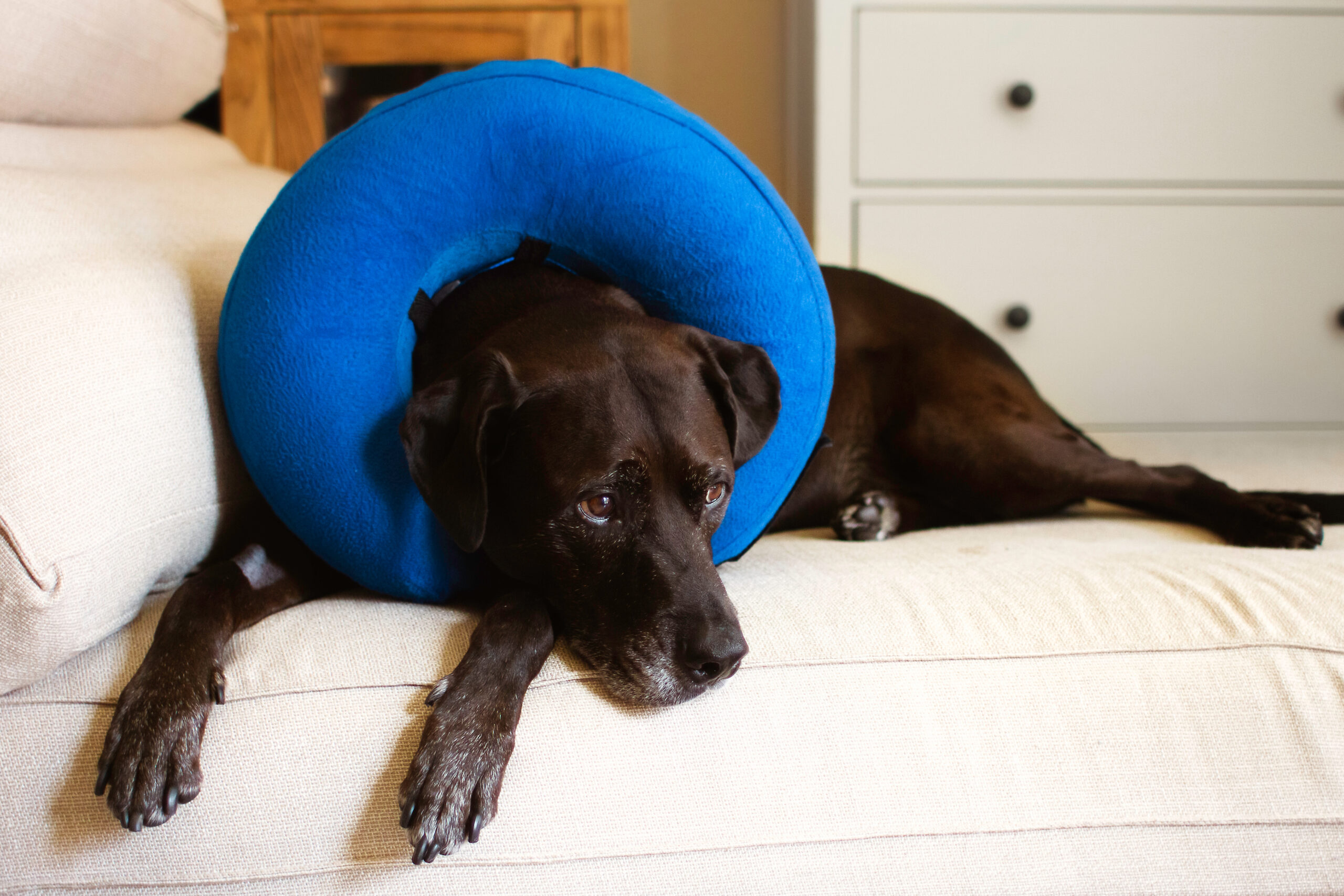When you have a dog, accidents happen. Whether your best friend stepped on glass, got injured while playing with a stick, or was bitten by another animal, it’s important to understand how to properly care for your dog’s wound.
While you can care for some wounds at home, others really need proper veterinary care. Understanding how to tell the difference is key.
What situations most commonly cause wounds in dogs?
Dogs can get wounded in many different ways. Fights with other dogs or animals commonly result in cuts or scrapes. It’s also possible for your dog to get wounded by stepping on a sharp object, like a stick or rock, while playing.
Just like human children, our canine kids also tend to get cut and banged up for no apparent reason after a day of play. Most of the time, these bumps, bruises, and cuts are nothing to worry about.
Wounds can also occur from more traumatic events, like car accidents, which is why it’s important to know proper safety protocol for your pup if you’re going for a drive.
What wounds require veterinary attention?
While you can treat some wounds at home, there are certain circumstances where your dog definitely needs to see a vet:
- Wounds resulting from a trauma, like a car accident; it’s possible your dog might be suffering from internal damage, in addition to external wounds
- Bite wounds from other animals, like snake bites, even if they are small
- Wounds that are in, on, or near the eye
- Wounds in which skin has been torn away from the flesh
- Wounds that continue to bleed after you’ve applied direct, steady pressure for 10 minutes
- Injuries where foreign objects are deeply embedded
- Wounds involving a large portion of the body, deep lacerations, or wounds that are highly painful
Rushing your pup to the vet after an accident can be stressful—not to mention expensive. Luckily, a base policy with Lemonade Pet insurance helps cover the costs of diagnostics, procedures, and medication related to unexpected accidents and illnesses.
Dog health insurance would likely help cover the veterinary costs related to emergency wound care, like cleaning, stitches, and any medications to help your pup get healed up in no time.
What wounds can be handled at home?
You can probably treat minor cuts, scrapes, and other wounds at home, but might be wise to consult your vet if you aren’t exactly sure what the next course of action is.
It’s best to take your dog to the vet if a wound involves a large or sensitive area of the body, is bleeding heavily, fully penetrates the skin like a deep puncture, or if you can see pus, bone, tendons, or (sorry for the visual) guts.
Create a first aid kit for your dog
It’s a good idea to prepare a first aid kit for your dog, so you can safely and effectively care for minor wounds at home.
Be sure to include the following items in the kit:
- Antiseptic solution, like 2% chlorhexidine (if cleaning near a mucus membrane, be sure to dilute the 2% solution to 40:1)
- Triple antibacterial ointment for dogs (Neosporin is also fine if you can’t get ahold of a dog-specific ointment)
- Clean towels or rags
- Disposable gloves
- Tweezers
- Muzzle
- Self-adhesive bandages
- Sterile bandage pads
- Sterile gauze
- Elizabethan collar (e-collar) or inflatable collar

How to clean and disinfect minor wounds
- Position your dog so that you can easily reach the wound. Big dogs can probably stay ground level, but you might want to put smaller dogs on a counter or table.
- Consider using a muzzle. Even though your dog might not bite you under normal circumstances, dogs who are in pain or afraid may nip or bite.
- If there is hair on and around the wound, clip it. Apply a water-based lubricant to the area, then use electric clippers to shave the hair from the area around the wound. Wipe the remaining lubricant away.
- Wash away any debris with warm water and soap from the shower or in the sink, then pat the area dry with a clean cloth.
- Apply an antiseptic to the area. Use a non-stinging antiseptic like chlorhexidine or povidone-iodine.
- Apply a triple antibiotic ointment to the wound.
- Apply a bandage. Depending on the wound’s location, you may want to apply a sterile bandage pad and use a self-adhesive bandage to keep the pad in place.
- Keep your dog from licking the wound. An e-collar can help with this.
You will need to clean the wound with the antiseptic and reapply the antibiotic ointment once a day until the wound heals.
It’s also important to carefully monitor the wound. If it doesn’t continue to heal, starts to ooze pus, or becomes more swollen, your dog will need to see the vet. These are potential signs of infection and indicate that your dog’s wound may need to be professionally cleaned, and take a round of antibiotics.
What not to do with dog wounds
When treating your dog’s wound, be sure to avoid these common mistakes:
- Don’t use rubbing alcohol or hydrogen peroxide to clean the wound. Both are harsh and can damage the skin and slow down the healing process. Instead, use a gentler cleanser like chlorhexidine.
- Don’t let your pup bite or lick at the wound, which can spread bacteria and potentially lead to infection. An e-collar can prevent your dog from accessing the wound.
- Don’t attempt to treat a wound that’s too much to handle at home. If your dog won’t let you safely touch the area, or if the wound is deep or severe, it’s important to get some professional help. Bring your dog to the vet ASAP so they can work to prevent infection, rather than having to treat an active infection.
- Don’t bandage too tightly. This can cut off your pup’s circulation.
What about dog paw wound care?
Sticks, broken glass, rocks, and even hot pavement in the summer can all cause wounds on your dog’s paws. If the wounds are minor, you can care for them at home:
- If needed, clip any hair from the surrounding area of your dog’s paw so you can get a clear look at the wound.
- Gently flush the wound using water or a diluted chlorhexidine solution to remove any debris or dirt. If there is any metal or glass or large pieces of debris stuck in the skin, it may be best to consult your veterinarian before trying to remove at home.
- If the wound is bleeding, use a clean towel to apply pressure to the wound. Maintain that pressure until the wound stops bleeding.
- Assess the wound. You will need to take your dog to the vet if you can’t get the bleeding to stop, if the wound is deep and requires stitches, or if there is any debris remaining in the paw.
- Put a small amount of triple antibiotic ointment on the wound.
- If the wound is more than just a scrape, you may need to apply a bandage to the paw. Start with a non-stick gauze pad, then wrap the paw with rolled gauze or an elastic bandage. Make sure that you can slide two fingers beneath the bandage so you don’t cut off circulation.
- Keep the bandage dry and replace it daily. Until the wound heals, maybe skip long walks or trips to the dog park, to speed up the healing process as much as possible.
- Consider using an Elizabethan collar if your dog is tempted to chew or lick at the bandage or paw.
To prevent dog paw wounds in the first place, carefully check the areas where you walk or let your dog out to play, and remove any sharp objects.
Try to keep your dog off of hot sidewalks in the summer and from icy or salty areas in the winter. You can also purchase boots for your dogs to give some extra protection when you head out together in harsh weather. If your pup doesn’t dig boots, a paw wax, like Musher’s Secret, can create a breathable barrier from the elements for your pup’s paws.
Dog wound daily care and treatment
It’s important to carefully monitor the wound during the healing process. Remove any bandage daily and inspect the wound. You may need to reapply antiseptic ointment, and should also look for any signs of infection, like pus, or any increase in swelling or pain.
If your vet gave your pup some stitches, you will need to care for those. Restrict your dog’s activity to keep your pup from accidentally tearing the stitches. That might mean keeping your best friend home from doggy daycare and foregoing playtime for a week or two.
Check the wound site daily and clean out any surgical drains according to your vet’s instructions. Keep the sutures dry and avoid bathing your dog.
If your dog attempts to lick the sutures, then consider using an e-collar or inflatable donut to protect those sutures. Your vet will also advise you about whether you need to bring your dog back in to have those stitches removed, or if they’ll dissolve on their own.
Before we go..
Chances are that at some point, your best friend will sustain a cut or wound. You can care for minor wounds at home, but deeper, more serious wounds really need vet treatment. If you’re uncertain about whether a wound is something that you can treat at home, don’t hesitate to call your vet’s office for advice.
A few quick words, because we <3 our lawyers: This post is general in nature, and any statement in it doesn’t alter the terms, conditions, exclusions, or limitations of policies issued by Lemonade, which differ according to your state of residence. You’re encouraged to discuss your specific circumstances with your own professional advisors. The purpose of this post is merely to provide you with info and insights you can use to make such discussions more productive! Naturally, all comments by, or references to, third parties represent their own views, and Lemonade assumes no responsibility for them. Coverage and discounts may not be available in all states.





